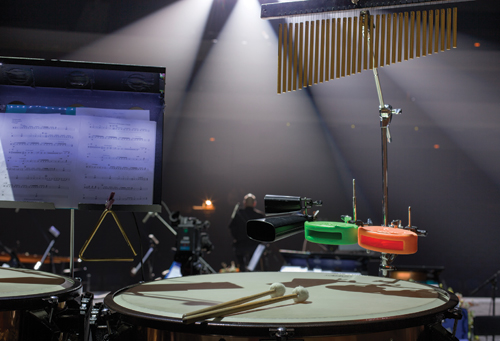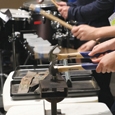
Rehearsing and performing a musical is a unique experience for students and teachers. Instrumentalists in the pit orchestra create sounds and perform styles they have perhaps never explored before. Success with these tasks requires them to develop and expand their technical facility and creativity in new ways. Percussionists face this challenge in heightened form, because of how many instruments they are asked to play and the varied techniques for playing them.
Young percussionists can learn quite a lot in the orchestra pit with common sense and a bit of guidance from their teachers. None of what follows is complicated; all of it is feasible. Most important, music teachers of any background can apply these approaches not only to coaching percussionists in the pit but across the instrumental curriculum.
Listening Experience
As with any repertoire development, broad and deep listening is essential. In addition to studying the particular musical they will be playing, pit percussionists should listen to numerous examples of the styles indicated in their parts. Online music streaming websites make this step easy. Help students determine appropriate keywords to find tracks demonstrating salient aspects of style indicators like “Stately March,” “Raucous Blues,” “Country Swing,” or “Viennese Waltz.” Music teachers know these musical flavors cannot be easily described. Guide them to listen to examples instead. Broad listening experiences will help students grasp essential style characteristics, enabling them to make appropriate interpretative choices and play more sensitively.
Composers of musicals often write a vague version or caricature of a style, requiring players to internalize the defining characteristics of that style and project them clearly through their playing. Many percussion parts for Broadway shows are notated rather sparsely – especially for the drumset – so percussionists should use their aural repertoire to decide exactly what and how to play. In addition to online music streaming websites, canned styles in audio editing and notation software programs can be a valuable reference for this aural information. Although students should be careful not to let digital examples become a complete model for their playing, they can use them like an encyclopedia of musical style information.
Practicing the Instruments
Pit percussion parts usually contain a wide range of instruments, including drumset, timpani, mallet instruments, and many accessories (e.g., tambourine, cowbell, triangle, and woodblock), to be covered by one or two players. Some percussion students tend to gravitate towards certain instruments and neglect others in their general studies. For example, the star snare drummer in high school might not play mallets, or the pianist-turned-keyboard-
Directors should review the percussion instrumentation for an upcoming musical and guide students to practice those instruments early and often prior to rehearsals. Reviewing the instrumentation will also alert percussionists and directors to instruments that need to be purchased, found, or made. Percussion students should learn to be creative about producing particular sounds, and teachers can help them develop the innovation and resourcefulness to find just the right one for a given situation. For example, the score may call for a ship’s bell, anvil, car horn, or whip. Where can students go to get these? They might check the school shop or local junkyard, or ask parents, teachers, or community members that work with such items and materials. Sometimes people are trying to get rid of old stuff that could be converted into the perfect instrument. With a bit of financial resources, teachers can find great sounds at the local pawn shop or garage sale as well.
Sticks and Mallets
To achieve a desired sound, students also must make wise stick or mallet choices. For example, a ship’s bell might be played with a plastic mallet, metal triangle beater, small utility hammer, or wooden rod. Any of these could provide the ideal sound, depending on the musical situation. On the wind chimes a student might play a glissando with a finger, a stick, or a triangle beater, and down towards the bottom or lightly across the sides, each combination producing a unique effect. Young percussionists need to know that sticks and mallets do not have to be standard, commercially available items; I have used coins, small chains, chopsticks, knitting needles, and claw hammers in the professional pit regularly.
Percussionists will likely use multiple versions of sticks and mallets during the course of a show or even a single tune. For example, they might use thin drumsticks for the two-beat dance number on the drumset, but larger sticks for the big snare drum roll on the trumpet fanfare. On the timpani, they could play with harder mallets near the edge of the drum for the exciting drumroll introducing the entr’acte, but then switch to softer, heavier mallets played in the sweet spot for the dramatic funeral scene. The materials with which the mallets are made and the hardness and weight of the mallet head make a big difference in the sound and mood of the passage. Students can also use a variety of sticks and mallets to get just the right sound on a single note. For example, a simple x| quarter note might suggest that a cymbal be struck sharply with a wooden stick, calmly with a fluffy mallet, or anything in between.
Given these considerations of ideal instrument and mallet choices, students may find themselves needing to switch between sounds and instruments too quickly. In these situations they can hold multiple mallets or use double-ended mallets. Holding multiple mallets enables players to shift quickly, for example, from a suspended cymbal roll with two soft mallets to an immediate triangle note. Standard three- or four-mallet grips learned for marimba or vibraphone solos work well; students will simply need to adjust their grip to hold, in this case, one of the soft mallets and one triangle beater in one hand. Players can also use double-ended mallets; some common examples are standard drumsticks with timpani or bell mallet heads on the back ends, bell or xylophone mallets with timpani mallet heads on the back ends, and snare drum sticks with a bit of metal around the back end or shoulder for quick shifts to the triangle. Double-ended mallets are commercially available, but can also be made by students relatively easily. Students may enjoy making just the right combination of tips, and may also want to create other combinations not available on the market for a particular musical situation.
Preparing the Part
The musical situation is mostly determined by the notated part in Broadway musicals, and students need to prepare their part thoroughly to play well. Percussion parts for many musicals are somewhat sketchy, so students will need to interpret them wisely, using their listening experience to grasp the right idea and clarify the notation. Some parts include cues, but generally rather few. Students will need help learning to mark cues thoughtfully, taking into consideration the most salient instruments in a given passage, the most consistent players in the ensemble, and their physical ability to hear certain parts of the orchestra from their location in the pit.
During rehearsals, students should also be prepared to make numerous notes to themselves to help them perform the part effectively. Professional percussionists’ pit parts are usually full of scrawled messages like “Hang slide whistle around neck now!” or “Get bass drum mallet ready!” Reminders like these help players prepare for their entrances way ahead of time, in a moment when it is feasible. After that moment has passed, they may have no later opportunity to prepare such things because they sometimes play without stopping for quite some time.
Percussionists are also well known for counting rests, a task they must learn to do accurately and consistently. Because they sometimes wait for extended periods before their entrances, they can mark and follow meter changes, key changes, written cues, and their own added cues to guide them. In most cases, however, there is simply no substitute for focused attentive counting. Surprisingly, what seems like a simple task can be quite difficult to maintain. One strategy students can use is marking additional cues within long stretches of rest. For example, in a bracketed section of 28 measures of rest, a student might write “11” as a reminder that a prominent entrance occurs in the ensemble at the eleventh measure of that section.
Arrangement in the Pit
Finally, students need to set up their instruments and music stand logically, in a way that is accessible at all times. The general arrangement of their instruments should reflect what they play most on a given production. For example, a show that calls for a lot of drumset with occasional bells and timpani would best be set up with the drumset directly between the player and conductor, and the bells and timpani off to each side. Players should avoid turning their back to the conductor as much as possible, but sometimes it may be necessary. In those cases, they should determine what they feel most comfortable playing accurately and consistently in that situation, and place that instrument in that spot. For example, repeated quarter notes on a large suspended cymbal would be safer in the backwards position than complicated xylophone passages. While this tip may seem obvious, all too often students create their own problems by neglecting to think through logical reasons for their setup. This challenge is fairly unique to percussionists, and may require some basic coaching by directors.
The physical distance between player and instruments is paramount to successful performance. In general, they should keep everything as physically accessible and easily movable as possible. Setting and adjusting all instruments thoughtfully will increase their confidence and success during quick switches. Choice and adjustment of stools can be helpful in this regard, freeing students to tune the timpani quickly or balance themselves comfortably at the drumset pedals. On the other hand, stools sometimes get in the way, so students should be prepared to play the timpani on their feet, from a stool, or sometimes both, even within the same tune.
In general, players should take advantage of vertical space to keep instruments closer to them. Orchestra bells on an adjustable stand can be raised over the xylophone or timpani; suspended cymbals can be mounted on boom stands to position them exactly where desired. Professional percussionists often say there is no need to be a hero. Set up your instruments – and yourself – in a way that will make technical execution as effortless as possible.
To facilitate quick changes, students should also mount as many instruments as possible. They should not need to pick up instruments like triangle, tambourine, or ratchet, unless there is plenty of time to do so. All of these can be mounted safely and easily without negatively affecting their sound, and hardware designed for this purpose is commercially available. Players should use plenty of stick trays placed strategically in their setup. Standard padded trays or music stands covered with black towels will provide a place to set up and discard mallets quickly without making unwanted noise. Hopping across the setup to grab a mallet at the last second is no way to make a beautiful musical entrance.
Finally, students should put their music stand in a place with a good visual angle to the conductor and close to themselves. This is the advice directors might give to all instrumentalists all the time, but for pit percussionists the situation is complicated by multiple parts for multiple instruments. Players can adapt their book for ease of use, copying and taping certain pages for easier turns, and placing copies of pages on extra music stands for instruments that may be far away from their original stand.
Conclusions and Applications
All suggestions outlined in this article are applicable to other areas of percussion performance in schools. Here is a summary list of advice for teachers coaching percussionists in the pit, followed by examples of how each suggestion could apply to other learning environments.
• Listen broadly to examples of styles to be performed.
• Gather, create, and practice all instruments in the score well ahead of time.
• Choose, adapt, and create sticks and mallets for technical ease and musical effect.
• Mark the part with cues, notes to self, and reminders during long rests.
• Set up instruments, and yourself, in ways conducive to successful playing.
Many contemporary concert band and orchestra pieces are based on the music of a specific historical period, geographical area, or folk tradition. Directors can guide percussionists to listen not only to recordings of the pieces themselves, but also broader repertoire exemplifying the original music, to help students choose instruments, mallets, and techniques conducive to successful performance.
Teachers and students should try to have all instruments and mallets ready to go as soon as possible in the rehearsal cycle for any ensemble. All too often I have heard directors say, “Oh, right, Tommy, we need to get that brake drum [or gong mallet or thunder sheet or tambourine head] before the concert.” Students should have the right instruments and mallets, selected for good reasons, with plenty of time to practice them fully. Having these instruments in rehearsals from the beginning is also helpful, of course, to the rest of the ensemble as they listen and play.
In contemporary pieces, students are often playing from multiple percussion setups. When making quick changes between instruments, they may need to hold multiple mallets in each hand or create double-ended mallets. The examples cited earlier for use in the pit could also be helpful in such situations on stage. Technical challenges like shifting from a rhythmic ostinato on concert toms to a soft suspended roll, or from a boomy timpani roll to a subtle triangle note, can be solved by one or both of these approaches.
Drummers in jazz band may be looking at sparse notation, lead sheets, or nothing at all on the music stand. Helping them sharpen skills in recognizing cues, understanding form, and writing worthwhile notes on the part can be invaluable to their own development and the ultimate success of the ensemble. Jazz drummers are often responsible for transitions in meter, style, or tempo within a tune, and their indications written in the part can help them lead these effectively.
Finally, in all ensembles the physical proximity and arrangement of music stand, instruments, player, and conductor are a high priority for percussion performance. Rarely do percussion students remain in front of a single instrument for an entire concert – or even for one piece. Directors can coach students on how to set up their instruments and themselves logically prior to beginning, but more important, how to move smoothly and efficiently among instruments once the music has begun.






